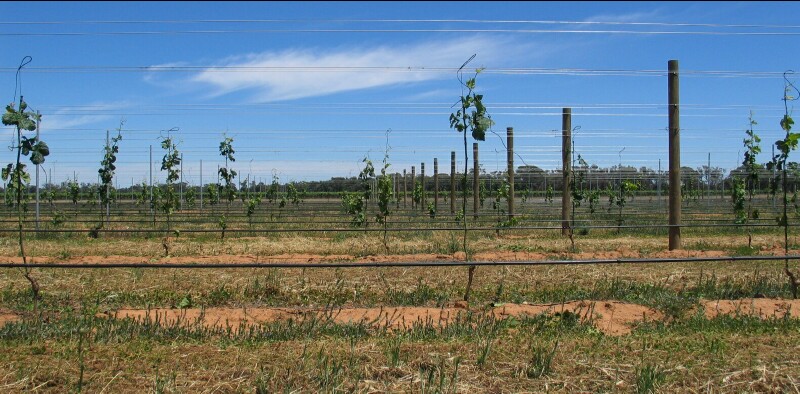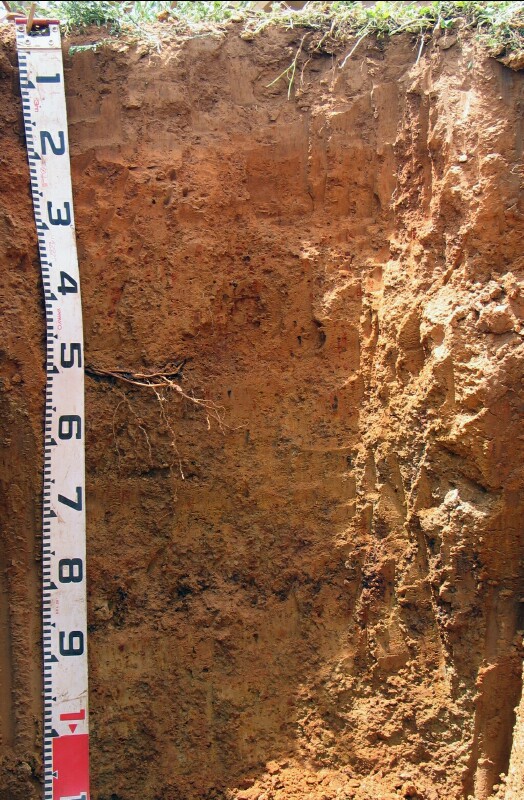VIT1
| Location: Rutherglen | |
| Aust. Soil Class: Sodic, Mesotrophic, Brown DERMOSOL |
 VIT1 Landscape |
Soil Profile Morphology:
Surface Soil
Ap | 0-15 cm | Brown (7.5YR4/3); fine sandy clay loam; weak coarse blocky structure; hard-setting surface condition; firm to very firm consistence (dry); many macropores present; pH 5.4; clear change to: |  Vit1 profile |
| Subsoil | |||
B1 | 15-30 cm | Strong brown (7.5YR4/6); light clay (fine sandy); weak to moderate subangular blocky structure; many fine to medium macropores; firm consistence (slightly moist); pH 6.0; gradual change to: | |
B21 | 30-50 cm | Strong brown (7.5YR5/6) with few (5%) dark red (2.5YR4/6) mottles; light medium clay (fine sandy); moderate – strong, medium to fine polyhedral structure; weak consistence (moist); few (5%) medium sized (5 mm) ferromanganiferous nodules; roots common to 60 cm; pH 6.1; gradual change to: | |
B22 | 50-70 cm | Brownish yellow (10YR6/6) with many (40%) strong brown (7.5YR5/6) mottles; medium clay; moderate - strong, medium to fine subangular blocky structure; weak consistence (moist); few (5%) medium (5-10 mm) ferromanganiferous and clay nodules; and few (5%) manganese stains; pH 6.6; gradual change to: | |
B23 | 70-95 cm | Light yellowish brown (2.5Y6/4) with many (30%) strong brown (7.5YR4/6) mottles; medium heavy clay; moderate – strong, medium to fine subangular blocky structure; firm consistence (moist); manganese staining common; few (5%) ferromanganiferous and clay nodules; roots to 80 cm; pH 7.6; gradual change to: | |
B24 | 95-110+ cm | Light olive brown (2.5Y5/4) with many (30%) reddish yellow (7.5YR6/6) mottles; strong – medium to fine subangular blocky; firm consistence (moist); few (2.5%) fine manganese flecks; pH 8.9. | |
- Gradual increase in texture (clay content) with depth down the soil profile.
Soil Profile Characteristics:
pH | Salinity Rating | Sodicity | Dispersion | |
Surface (Ap horizon) | Strongly Acid | Very Low | Non-Sodic | None |
Subsoil (B21 horizon) | Slightly Acid | Very Low | Non-Sodic | None |
Deeper subsoil (at 95-110+ cm) | Strongly Alkaline | Very Low | Strongly Sodic | Strong |

Horizon | Horizon Depth (cm) | pH (water) | pH (CaCl2) | EC 1:5 | Exchangeable Cations | |||
Ca | Mg | K | Na | |||||
meq/100g | ||||||||
Ap | 0-15 | 5.4 | 4.7 | 0.08 | 3.2 | 0.92 | 0.82 | 0.13 |
B1 | 15-30 | 6.0 | 5.2 | 0.06 | 3.1 | 1.7 | 0.37 | 0.26 |
B21 | 30-50 | 6.1 | 5.1 | <0.05 | 2.3 | 2.2 | 0.28 | 0.38 |
B22 | 50-70 | 6.6 | 5.2 | 0.07 | 2.0 | 4.4 | 0.43 | 1.4 |
B23 | 70-95 | 7.6 | 6.2 | 0.09 | 2.6 | 6.4 | 0.59 | 2.8 |
B24 | 95-110+ | 8.9 | 7.9 | 0.14 | 3.0 | 7.3 | 0.62 | 3.5 |
Horizon | Horizon Depth (cm) | Exchangeable Aluminium (mg/kg) | Exchangeable Acidity (meq/100g) | Field Capacity pF 2.5 | Wilting Point pF 4.2 | Coarse Sand (0.2-2.0 mm) | Fine Sand (0.02-0.2 mm) | Silt (0.002-0.02 mm) | Clay (<0.002 mm) |
Ap | 0-15 | <10 | 6.0 | 24 | 6.3 | 10 | 50 | 18 | 16 |
B1 | 15-30 | <10 | 4.6 | 23.3 | 8.4 | 7 | 43 | 16 | 31 |
B21 | 30-50 | <10 | 3.6 | 24.7 | 9.1 | 7 | 42 | 14 | 35 |
B22 | 50-70 | 5.1 | 25.8 | 12.4 | 7 | 34 | 15 | 41 | |
B23 | 70-95 | 29.1 | 16.3 | 5 | 31 | 17 | 48 | ||
B24 | 95-110+ | 30.4 | 15.4 |
Management Considerations:
Subsoil (B) Horizon
- The deeper subsoil (from 70 cm depth) becomes strongly sodic and dispersive. This will result in restricted root and water movement at depth.
- Roots common to 60 cm depth.
- Profile described by Mark Imhof and Kevin Powell (December 2004).


